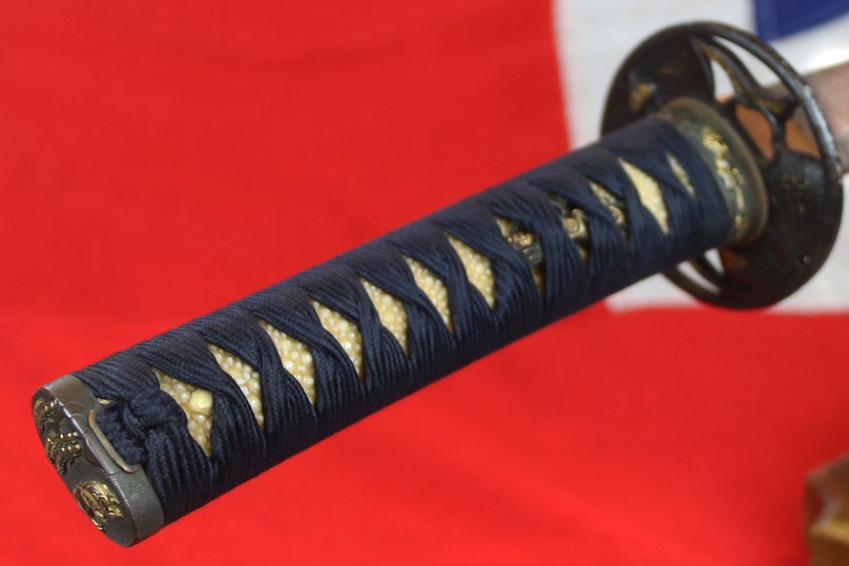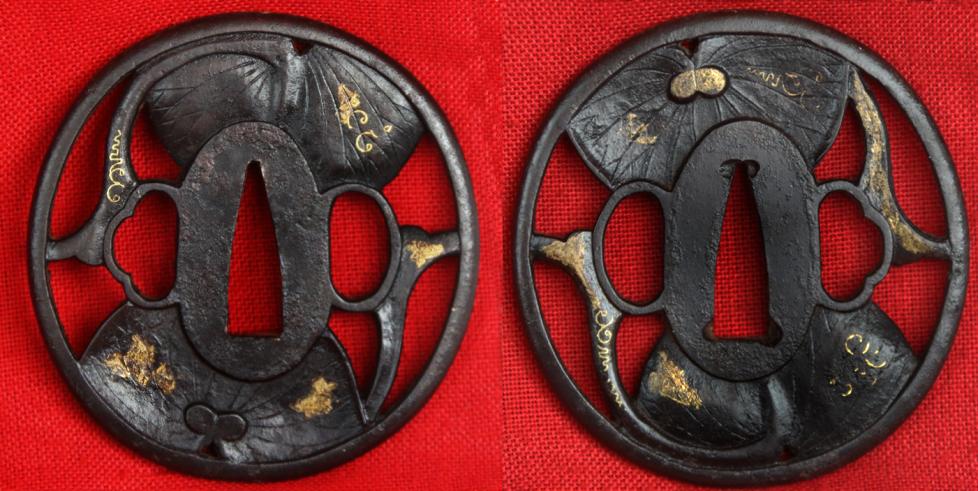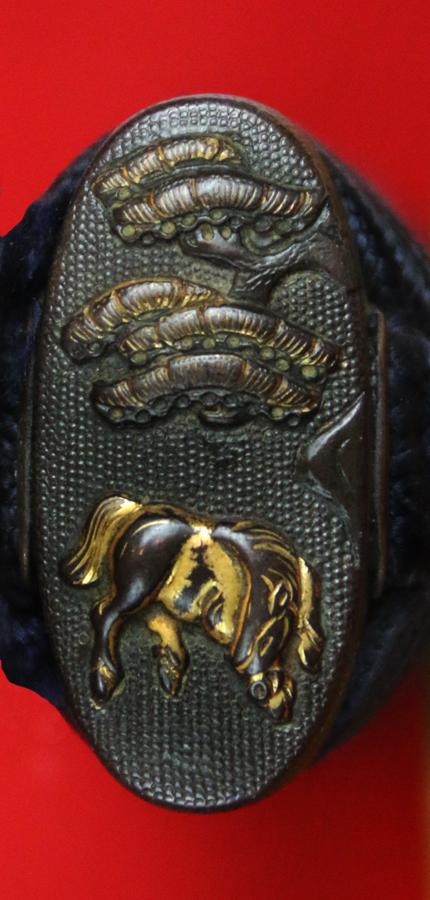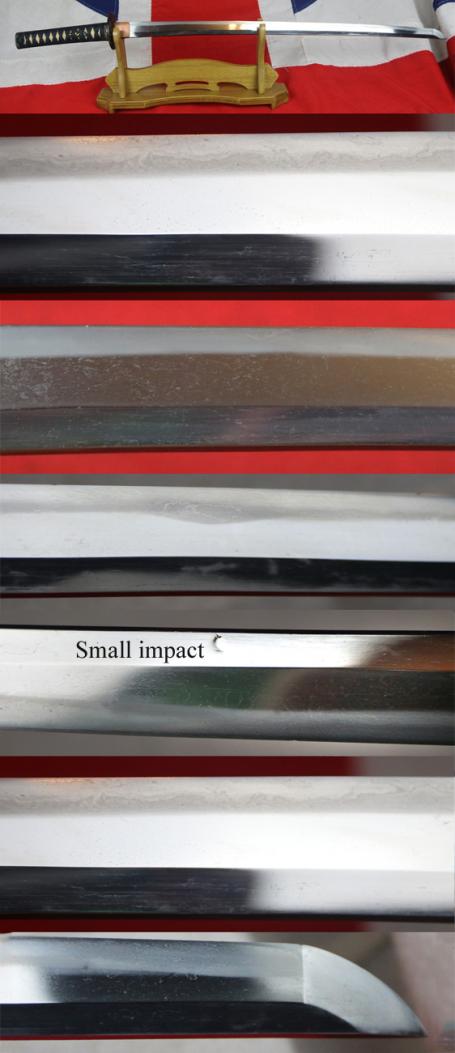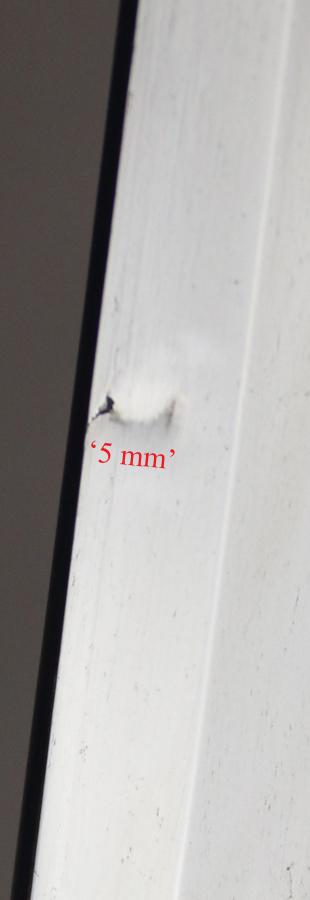An Absolute Beauty of a Fine, Koto Period Katana, Signed Bishu Osafune Kiyomitsu & Dated 1573 The Tsuba is Kinai School, a Sukashi Round Tsuba, of An Aoi,
A very good Koto period sword, with a beautiful polished blade. Two stage black lacquer saya with two tone counter striping at the top section and ishime stone matt lacquer at the bottom, it has an iron Higo style kojiri bottom chape inlaid with gold. The fuchigashira are shakudo copper with a nanako ground decorated with takebori carved ponies over decorated in pure gold, with bocage of a Japanese white pine tree above the pony on the kashira. The tsuba is a Kinai school sukashi round tsuba, in the form of an aoi, or hollyhock plant heightened with gold inlays, including Arabesque scrolls, and leaves. the tsuba came from likely a branch of the Miochin (Group IV), this family was founded by Ishikawa Kinai, who moved from Kyoto to Echizen province and died in 1680. The succeeding masters, however, bore the surname of Takahashi. All sign only Kinai Japanese text, with differences in the characters used and in the manner of writing them.
Futaba aoi is a Japanese term for the Asarum caulescens plant, which has two leaves and is often mistakenly called a "hollyhock" due to its use in the Aoi Matsuri festival. The distinctive heart-shaped leaves of futaba aoi are used to decorate participants and items in the Aoi Matsuri, which is a major festival in Kyoto. The plant is sacred to the Shimogamo and Kamigamo shrines and also served as the crest for the powerful Tokugawa Shogunate family.
The Kinai made guards only, of hard and well forged iron usually coated with the black magnetic oxide. They confined themselves to pierced relief showing extraordinary cleanness both of design and execution. Any considerable heightening of gold is found as a rule only in later work. Dragons in the round appear first in guards by the third master, fishes, birds, etc., in those of the fifth; while designs of autumn flowers and the like come still later. There are examples of Kinai tsuba in the Ashmolean and the British Museum. Made around to decades before but certainly used in the time of the greatest battle in samurai history "The Battle of Sekigahara" Sekigahara no Tatakai was a decisive battle on October 21, 1600 that preceded the establishment of the Tokugawa shogunate. Initially, Tokugawa's eastern army had 75,000 men, while Ishida's western army numbered 120,000. Tokugawa had also sneaked in a supply of arquebuses. Knowing that Tokugawa was heading towards Osaka, Ishida decided to abandon his positions and marched to Sekigahara. Even though the Western forces had tremendous tactical advantages, Tokugawa had already been in contact with many daimyo in the Western Army for months, promising them land and leniency after the battle should they switch sides.
Tokugawa's forces started the battle when Fukushima Masanori, the leader of the advance guard, charged north from Tokugawa's left flank along the Fuji River against the Western Army's right centre. The ground was still muddy from the previous day's rain, so the conflict there devolved into something more primal. Tokugawa then ordered attacks from his right and his centre against the Western Army's left in order to support Fukushima's attack.
This left the Western Army's centre unscathed, so Ishida ordered this unit under the command of Shimazu Yoshihiro to reinforce his right flank. Shimazu refused as daimyos of the day only listened to respected commanders, which Ishida was not.
Recent scholarship by Professor Yoshiji Yamasaki of Toho University has indicated that the Mori faction had reached a secret agreement with the Tokugawa two weeks earlier, pledging neutrality at the decisive battle in exchange for a guarantee of territorial preservation, and was a strategic decision on Mori Terumoto's part that later backfired.
Fukushima's attack was slowly gaining ground, but this came at the cost of exposing their flank to attack from across the Fuji River by Otani Yoshitsugu, who took advantage of this opportunity. Just past Otani's forces were those of Kobayakawa Hideaki on Mount Matsuo.
Kobayakawa was one of the daimyos that had been courted by Tokugawa. Even though he had agreed to defect to Tokugawa's side, in the actual battle he was hesitant and remained neutral. As the battle grew more intense, Tokugawa finally ordered arquebuses to fire at Kobayakawa's position on Mount Matsuo to force Kobayakawa to make his choice. At that point Kobayakawa joined the battle as a member of the Eastern Army. His forces charged Otani's position, which did not end well for Kobayakawa. Otani's forces had dry gunpowder, so they opened fire on the turncoats, making the charge of 16,000 men mostly ineffective. However, he was already engaging forces under the command of Todo Takatora, Kyogoku Takatsugu, and Oda Yuraku when Kobayakawa charged. At this point, the buffer Otani established was outnumbered. Seeing this, Western Army generals Wakisaka Yasuharu, Ogawa Suketada, Akaza Naoyasu, and Kutsuki Mototsuna switched sides. The blade is showing a very small, combat, sword to sword, thrust from a blade tip, or, possibly a deflected arrow impact, this tiny wound so to speak should never be polished away, this is known as a most honourable battle scar, and certainly no detriment to the blade, and that likely saved the owner of the swords life in a hand to hand combat situation. See close up photo 9 in the gallery, tiny impact of around 1mm with slight bruising below over a maximum total length 5mm, max impact depth around 1mm
Code: 23305
8750.00 GBP



